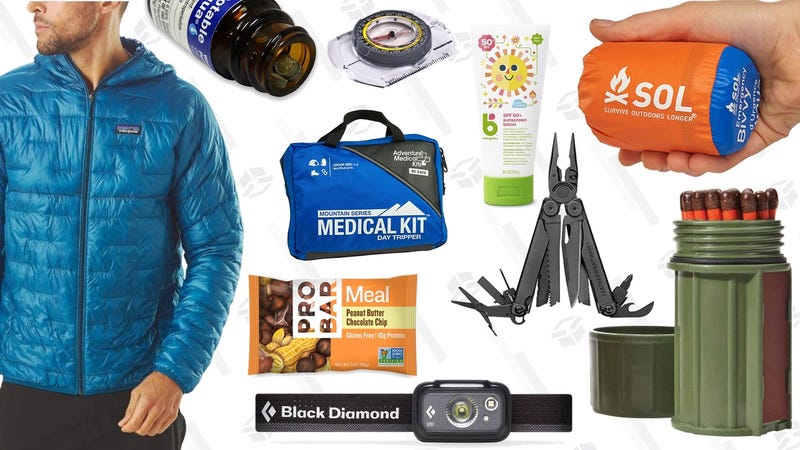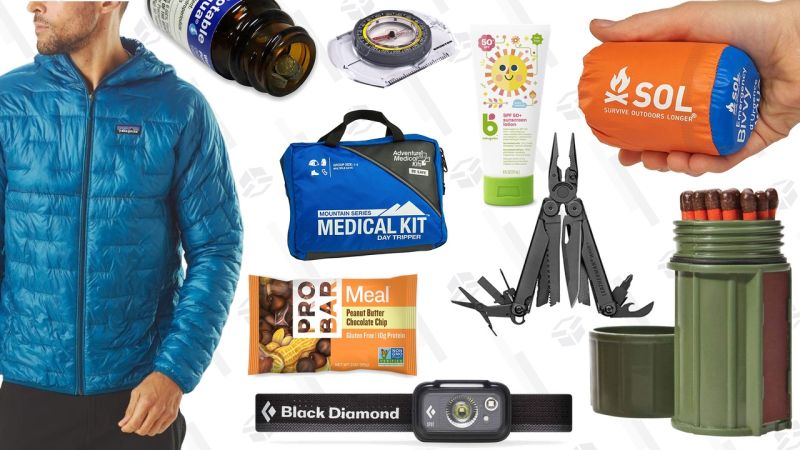
Everyone wants to be prepared when they hit the trail, and there is no better way to do that than The Ten Essentials. Developed in the 1970s, these ten items are the gear items you always need to be prepared for an on-trail emergency. Since then, the concept has evolved from single items to gear systems, but the premise remains the same: bring ‘em, love ‘em, and use ‘em.
Navigation: Brunton TruArc 3 Compass
Sure, it may feel easier to use a GPS system, or even your phone, but carrying a map and a compass is always a good idea. Bottom line: technology fails. Batteries die. Signals disappear. It would be a bummer to get lost, need your GPS, and realize it wasn’t working for one reason or another. The Brunton TruArc 3 compass covers the basics—tool-less declination compensation, metric and standard scales—at an affordable price. For less than $20, you literally have reason to leave it at home. (Now, go learn how to use it!)
Headlamp: Black Diamond Spot 325
If the worst happens, and you get stuck on the trail at night in an unplanned situation, it’s really helpful to be able to see. Flashlights are fine, but headlamps are better since they leave your hands free. The Black Diamond Spot 325 is a great bet thanks to its 325 lumens and 80-meter beam distance (on the highest setting). Plus, it’s durable and compact, so you don’t feel like you are lugging around a bowling ball. Tip: Pack extra batteries.
Sun Protection: Babyganics SPF 50+ Sunscreen & Oakley Flak 2.0 Sunglasses
Keeping the sun off your skin as much as possible is critical if you are outside longer than planned. Of course, your apparel will do a greatjob of protecting your arms and legs, but don’t forget sunscreen and sunglasses too. I prefer Babyganics sunscreen. Not only is it SPF 50+, but it uses zinc oxide and titanium to create a physical shield rather than a chemical one. The upshot: no chemicals on your skin.
If you’ve ever spent long periods of time on the snow or water without sunglasses, you know how bad (and potentially dangerous) it can be to leave your eyes unprotected. The Oakley Flak sunglasses have enhanced lens coverage, but are still lightweight and durable so they won’t shatter if you drop them on the ground. You can choose whichever lens technology you want, but rest assured that any of them will do the job.
First Aid: Adventure Medical Kits Mountain Day Tripper Kit
It can be easy to forgo first aid supplies on a day hike, and I totally get it. After all, we’ve all said those immortal words: What could go wrong? Don’t be that person and always pack a small first aid kit with you. The Mountain Day Tripper is affordable and includes all the basic stuff you’d need for an emergency: assorted bandages, blister preventions, pain medication, wound care and antiseptics, and gloves.
Knife: Leatherman Wave+
A basic knife/multitool is invaluable in an emergency. Not only can the various apparatuses fix gear, but the tool can help with food prep, firewood, or even first aid. The Leatherman Wave+ is a classic option that still comes with all the bells and whistles like wire cutters, pliers, a wire stripper, and multiple knives. Basically, this useful gadget is a one-stop-shop for all things emergency.
Fire: UCO Gear Stormproof Matches
The ability to make a fire for warmth and/or cooking is paramount in a dire situation. The UCO Stormproof matches are practically bombproof; they light up in driving wind, rain, and even after they’ve been fully submerged in water (trust me, I tried). It’s a great idea to always carry multiple fire sources in case one fails, but consider making these matches one of your options.
Shelter: SOL Emergency Bivvy
If you become injured or stranded while on the trail and there is no one to help you, an emergency shelter could literally save your life. You have many options—a tarp, a space blanket, or even a trash bag—but my fave is the Emergency Bivvy by SOL. It is tear-resistant, and reflects 90% of your body heat back to you to help prevent hypothermia in cold weather. And, it weighs less than four ounces so there really is no excuse for leaving it behind.
Extra Food: Probar Meal Bars
We all know we should carry an emergency stash of calories, but here’s another tip: make sure your surplus food doesn’t require cooking. After all, what good is food you can’t eat if your stove is incapacitated? Major bummer. I love Probar Meal bars for their simplicity. No cooking required, they taste good, and each bar has at least 350-400 calories. Plus, chocolate and peanut butter is the best combination ever created.
Extra Water: Potable Aqua Iodine Tablets
Never skimp on your water. As a starting point, consider that most people need at least a half a liter of water per hour of moderate activity. That said, it is very important to have a means of acquiring more should you run out. For this, there are two options: a water filter or water treatment tablets. The Potable Aqua Iodine Tablets are the most basic choice of the group, but they make it easy. They’re affordable, ultralight, packable, and simple to use (if you can get around the flavor).
Extra Clothes: Patagonia Micro Puff Jacket (Men | Women)
Always, always bring extra clothes with you so you are protected during an unplanned evening outside. For me, I typically pack what I call a “crisis puffy.” This is an ultralight-yet-warm insulated jacket that weighs practically nothing yet will keep me warm in an emergency. Currently, one of my favorites is the Micro Puff. It uses synthetic insulation (rather than down) which means it retains heat even when damp. Plus, it packs down to the size of a grapefruit so it barely uses any space in my backpack.























